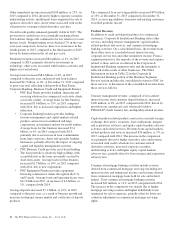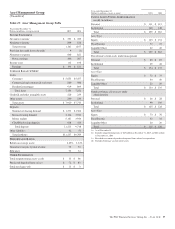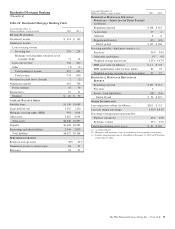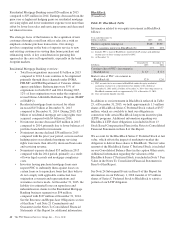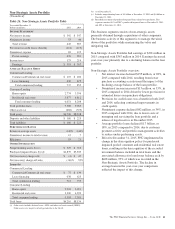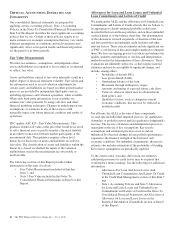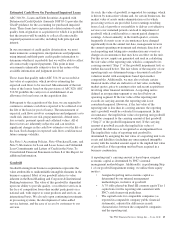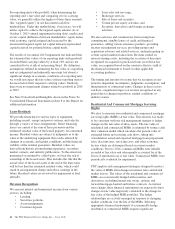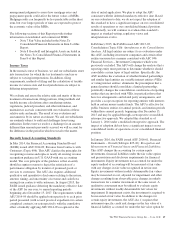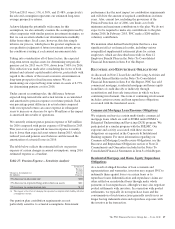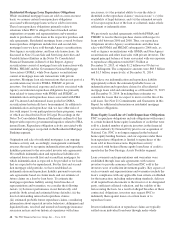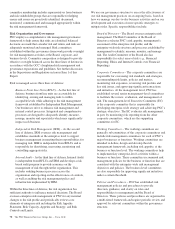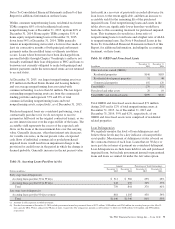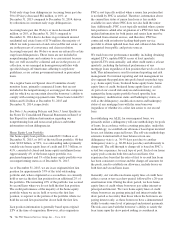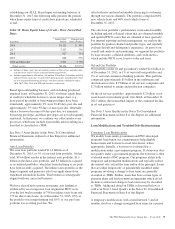PNC Bank 2015 Annual Report Download - page 84
Download and view the complete annual report
Please find page 84 of the 2015 PNC Bank annual report below. You can navigate through the pages in the report by either clicking on the pages listed below, or by using the keyword search tool below to find specific information within the annual report.
presented in other comprehensive income, 2) clarifies that an
entity should consider deferred tax assets related to available-
for-sale securities when evaluating the need for a valuation
allowance on deferred tax assets, 3) eliminates the
requirement for entities to disclose the methods and
significant assumptions used to estimate disclosed fair values
for financial instruments measured at amortized cost, 4)
requires that the disclosed fair values represent an exit price,
and 5) requires that financial assets and liabilities be presented
by measurement category and form of instrument on the
balance sheet or within the accompanying notes to the
financial statements. The ASU is effective for annual periods,
and interim periods within those annual periods, beginning
after December 15, 2017 and should be applied through a
cumulative-effect adjustment to the balance sheet, except for
the amendment related to equity securities without readily
determinable fair values, which should be applied
prospectively. We plan to adopt all provisions consistent with
the effective date and are currently evaluating the impact of
this ASU on our results of operations and financial position.
Recently Adopted Accounting Pronouncements
See Note 1 Accounting Policies in the Notes To the
Consolidated Financial Statements in Item 8 of this Report
regarding the impact of new accounting pronouncements
which we have adopted.
S
TATUS OF
Q
UALIFIED
D
EFINED
B
ENEFIT
P
ENSION
P
LAN
We have a noncontributory, qualified defined benefit pension
plan (plan or pension plan) covering eligible employees.
Benefits are determined using a cash balance formula where
earnings credits are applied as a percentage of eligible
compensation. Pension contributions are based on an
actuarially determined amount necessary to fund total benefits
payable to plan participants. Consistent with our investment
strategy, plan assets are primarily invested in equity
investments and fixed income instruments. Plan fiduciaries
determine and review the plan’s investment policy, which is
described more fully in Note 12 Employee Benefit Plans in
the Notes To Consolidated Financial Statements in Item 8 of
this Report.
We calculate the expense associated with the pension plan and
the assumptions and methods that we use include a policy of
reflecting plan assets at their fair market value. On an annual
basis, we review the actuarial assumptions related to the
pension plan. The primary assumptions used to measure
pension obligations and costs are the discount rate, mortality,
compensation increase and expected long-term return on plan
assets. Among these, the compensation increase assumption
does not significantly affect pension expense.
ASC 715-30 and ASC 715-60 stipulate that each individual
assumption, including mortality, should reflect the plan
sponsor’s best estimate. PNC has historically utilized a
version of the Society of Actuaries’ (SOA) published
mortality tables in developing its best estimate of mortality.
On October 27, 2014, the SOA published a new study on
mortality rates that included updated mortality tables and
mortality improvement scale, which both reflect longer life
expectancy. Based on an evaluation of the mortality
experience of PNC’s qualified pension plan participants in
conjunction with the updated SOA mortality study, PNC
adopted an adjusted version of the SOA’s new mortality table
and improvement scale for purposes of measuring the plan’s
benefit obligations at December 31, 2014. During 2015, the
SOA released an updated mortality improvement scale that
generally validated the information that was considered when
setting the current assumption, which remains unchanged
from the mortality assumption adopted in 2014.
The discount rate used to measure pension obligations is
determined by comparing the expected future benefits that
will be paid under the plan with yields available on high
quality corporate bonds of similar duration. The impact on
pension expense of a .5% decrease in discount rate in the
current environment is an increase of $18 million per year.
This sensitivity depends on the economic environment and
amount of unrecognized actuarial gains or losses on the
measurement date.
The expected long-term return on assets assumption also has a
significant effect on pension expense. The expected return on
plan assets is a long-term assumption established by
considering historical and anticipated returns of the asset
classes invested in by the pension plan and the asset allocation
policy currently in place. For purposes of setting and
reviewing this assumption, “long term” refers to the period
over which the plan’s projected benefit obligations will be
disbursed. We review this assumption at each measurement
date and adjust it if warranted. Our selection process
references certain historical data and the current environment,
but primarily utilizes qualitative judgment regarding future
return expectations.
To evaluate the continued reasonableness of our assumption,
we examine a variety of viewpoints and data. Various studies
have shown that portfolios comprised primarily of U.S. equity
securities have historically returned approximately 9%
annually over long periods of time, while U.S. debt securities
have returned approximately 6% annually over long periods.
Application of these historical returns to the plan’s allocation
ranges for equities and bonds produces a result between 6.50%
and 7.25% and is one point of reference, among many other
factors, that is taken into consideration. We also examine the
plan’s actual historical returns over various periods and
consider the current economic environment. Recent
experience is considered in our evaluation with appropriate
consideration that, especially for short time periods, recent
returns are not reliable indicators of future returns. While
annual returns can vary significantly (actual returns for 2015,
66 The PNC Financial Services Group, Inc. – Form 10-K


